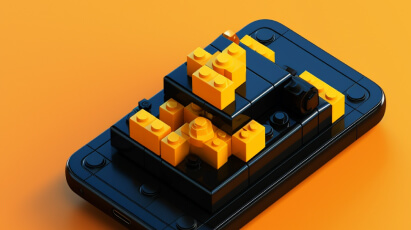
The larger a digital product becomes, the more complex it can be to maintain. This can result in it taking longer to create designs and implement changes. Different areas of the product may start to feel disconnected and inconsistent, making it harder for users to navigate and engage.
Is your product starting to feel a bit chaotic? Creating a design system will help bring some order to the chaos.
Picture a toolbox filled with reusable design assets, guidelines, and best practices that can be used to create a consistent and cohesive user experience across all touchpoints of a digital product. This toolbox is a design system. It can include design patterns, UI components, typography, color palettes, iconography, and other visual and interaction design elements.
The beauty of a design system lies in its ability to establish a shared language and understanding of design among cross-functional teams, including designers, developers, and product managers. It ensures consistency across a digital product, making it easier for users to navigate and use the product. It also improves the efficiency of the design process, as designers can leverage existing design assets and guidelines instead of starting from scratch with each new design. The question then becomes, how do we get started?
How should you start creating a design system?
Here are some of the essential steps you can follow to start a design system:
- Create the UI Inventory for the Design System: The first step in creating a design system is to conduct a thorough inventory of all existing UI elements used in the product. This inventory should include all buttons, forms, navigation elements, and other design elements used throughout the product.
- Research other design systems: This can provide inspiration and help to identify common patterns and best practices. This research can include reviewing other design systems, attending design conferences, and reading design blogs and articles.
- Get Organizational Buy-In for the Design System: It is important to ensure that all stakeholders are aware of the design system and support its implementation. This can be achieved by presenting the benefits to key decision-makers and demonstrating how it will improve the products’ design and user experience.
- Build a Multidisciplinary Design Systems Team: This team should include designers, developers, and other stakeholders who will contribute to the design system.
- Build the Color Palette and Typographic Scale for the Design System: This color palette should be consistent with the brand's color scheme and be used throughout the product to maintain consistency. The typographic scale should include font sizes, line heights, and other typographic elements that will be used throughout the product.
- Standardize Other Style Properties: Design decisions also include finalizing grid styles and other properties that are not covered in the previous sections, such as white space. These properties should be standardized to ensure consistency across the product.
- Create a component library in a tool like Figma: This library should include all the UI elements that were identified in the UI inventory, as well as any new UI elements that are developed for the design system.
- Document the Design System: This documentation should include guidelines and best practices for designers and developers to follow, as well as documentation on how to use the design system. This will ensure that the design system is consistently used across the product and by all stakeholders.
What are design system principles?
While all design system principles are important, some of the most essential ones include:
- Consistency of all UI components across products, platforms, and devices.
- Reusability across different projects, reducing development time and ensuring consistency.
- Scalability to ensure that the design system remains relevant and effective as the product and company grow.
- Accessibility as a priority, to ensure that all users, including those with disabilities, can effectively use the product.
- Usability of the design system, making it easy for designers and developers to find and use components and design elements.
- Documentation of the design system, streamlining the onboarding of new team members to understand and use the system effectively.
By prioritizing these principles, a design system can provide a foundation for a consistent, efficient, and effective design process.
What are some design system references?
When building a design system it can be helpful to reference existing design systems to get a better understanding of what works well and what doesn't. Here are some of the best design systems to consider:
- Google's Material Design system: This is widely recognized as one of the most comprehensive and well-designed systems. It features a robust set of design guidelines and components for web, mobile, and desktop interfaces.
- IBM's Design Language provides a set of principles, guidelines, and design components for creating enterprise-grade products, emphasizing accessibility, inclusivity, and user-centered design.
- Atlassian's Design Guidelines provide a comprehensive set of design patterns, principles, and best practices for designing products in the Atlassian ecosystem. It includes design resources for web and mobile platforms.
- Shopify’s Polaris provides guidelines and design resources for creating cohesive, user-friendly experiences across all of their products, and includes design components for web and mobile interfaces.
- The Salesforce Lightning Design System provides a set of design guidelines, principles, and components for creating enterprise-grade products on the Salesforce platform, emphasizing modular design and usability.
These design systems can give you some inspiration and help you see how other companies have tackled similar design challenges. It's important to keep in mind that your design system should be tailored to your specific product, and not simply copied from existing systems.
A design system is a tool that helps bring order to chaos in digital products. It ensures a consistent user experience across different parts of the product. By following the steps and principles outlined above, you can create a shared language across teams, as well as design and build products more efficiently. Your teams and users will thank you later.
